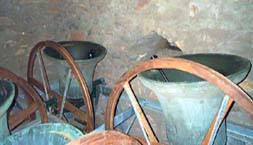Change Ringing is a way of ringing bells that produces a rich cascade of sound. The bells do not play hymns or tunes as do carillons. Change ringing bells are hung in special frames that allow the bell to swing through an arc of 360 degrees. A team of people are needed to ring them because each bell requires the full attention of one person.
 |
|
 |
Change ringing bells are rung from the mouth up position. When the rope is pulled, the bell falls, then rises again to the mouth up position. When the bell reaches that point, the ringer can pull it at the same interval as previously, allow the bell to rest there momentarily, or they can pull it slightly before it reaches the balance. These subtle controls are the essence of change ringing and what allow the bells to change positions. For a more detailed explanation of change ringing see this website. To hear change ringing, click on the bell.
Saint Mark's bells ringing Grandsire Triples
(recorded June 13, 1999)
Two websites with Java applets show how change ringing bells swing. Note, Both of these pages down load very slowly.
The first one shows how a bell ringer rings a bell full circle. Notice the hands of the ringer on the bell rope. One stroke is pulled from the end of the rope, and the other from the sally (the tuft of wool on the rope).
The second applet shows a series of bells which are in the "up" position. The sound is of handbells, and you can ring rounds or conduct a touch of a method. (I am told by my friends that this program doesn't run very well in Netscape, It seems okay in IE.)
An excellent explanation of change ringing is provided by Derek Sawyer, tower captain of Saint James Cathedral in Toronto in this CBC Broadcasting interview, which is available as on line text or as live video on real player.